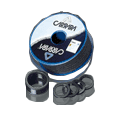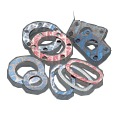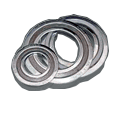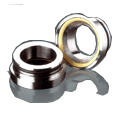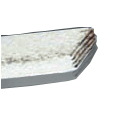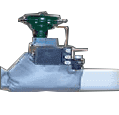Ever felt like you were trying to find the right hat for a giraffe? It’s not a common problem, but picking the right gasket can feel just as tricky.
Rubber gaskets, metallic gaskets, ones that look like they came off a spaceship – there’s a whole zoo of options. And let’s be honest: choosing the wrong one can turn your system from a well-oiled machine into a leaky, noisy nightmare.
That’s why Steamline Engineering – Australia’s go-to for gasket know-how – is here to untangle the confusion. We’ll break down the different types of gaskets and how to make sure yours fits like a glove (or, if you like, like a giraffe’s hat).
Metallic gaskets for a heavy-duty seal
Metallic gaskets are your go-to when pressure and temperature start to climb. Made from solid metals or blends, they deliver excellent strength and resilience, even in the toughest conditions. These types of gaskets are specifically designed for environments where other gasket materials would quickly fail.
- Common materials: Stainless steel, soft iron, copper
- Applications: High-pressure vessels, heat exchangers, petro-chemical pipelines
- Standout feature: Outstanding resilience and sealing power in extreme environments
Metallic gaskets are also well-known for their longevity, making them a cost-effective option in the long run. Their rigid structure means they’re ideal for static applications, providing a tight seal that keeps your equipment running smoothly and safely.
Non-metallic gaskets are reliable and versatile
Non-metallic gaskets step in when flexibility and adaptability are the name of the game. They’re ideal for lower-pressure jobs but still tough enough to keep things sealed tight. These types of gaskets are also favoured for their ease of installation – no fuss, no drama.
- Common materials: Rubber (EPDM, nitrile, neoprene), PTFE, graphite, compressed fibre
- Applications: Water systems, low-pressure pipelines, general industrial sealing
- Standout feature: Flexible and cost-effective, perfect for a wide range of uses
Non-metallic gaskets can handle temperature variations and are less likely to damage sensitive components, making them a favourite across industries like water treatment, food processing and general manufacturing.
Composite gaskets offer the best of both worlds
Composite gaskets mix the durability of metal with the softness of filler materials, giving you a gasket that can handle tricky conditions while maintaining a solid seal. These gaskets are designed to adapt to flange imperfections, providing a more reliable seal than either metal or soft materials alone.
- Common materials: Spiral-wound construction with alternating metal and soft filler layers
- Applications: Flanges with irregular surfaces, high-temperature steam lines
- Standout feature: Blends strength and flexibility for reliable sealing in tricky conditions
Because composite gaskets can cope with vibration and thermal cycling, they’re a top choice for equipment that operates under fluctuating loads or temperatures. You’ll find them in power stations, refineries and anywhere a reliable seal is crucial.
Soft cut gaskets are simple yet essential
When you need a gasket cut to a precise size and shape, soft cut gaskets are your best mate. They’re customisable and quick to replace, making maintenance a breeze. These gaskets are typically made from sheet materials and punched or cut to size for a perfect fit.
- Common materials: Graphite, PTFE, rubber sheeting
- Applications: Custom-fitted flanges and low-pressure systems
- Standout feature: Easy to cut, replace and maintain – the go-to choice for everyday maintenance
Soft cut gaskets are also a practical choice for equipment that sees frequent inspections and disassembly. Their low cost and easy handling mean you can always have spares on hand to keep downtime to a minimum.
Spiral-wound gaskets are trusted in tough environments
Spiral-wound gaskets stand out for their clever design – a balance of metal’s strength and soft filler’s flexibility. They’re the workhorse in systems that face both high pressure and high temperatures. These gaskets can handle repeated thermal cycling without losing their ability to seal.
- Common materials: Thin metal strip with soft filler material
- Applications: High-pressure steam, oil and gas pipelines
- Standout feature: Excellent recovery and robust sealing performance, even in fluctuating conditions
With their proven reliability, spiral-wound gaskets are a favourite in industries like mining, petro-chemical, and power generation – places where even a minor leak can lead to big problems.
Why choosing the right types of gaskets matters
Using the wrong type of gasket can lead to serious issues: leaks, safety hazards and costly downtime. That’s why it’s crucial to consider the following factors.
Operating conditions
Temperature, pressure and the type of fluid all play a big part in choosing the right gasket. A mismatch here can mean a seal that fails under stress, causing equipment damage and operational headaches.
Flange design
The flange’s face type – whether it’s flat or raised – and how well the surfaces align will influence which gasket fits best and seals effectively. Choosing the correct types of gaskets that match the flange ensures maximum reliability and safety.
Material compatibility
It’s essential to match the gasket’s material with the fluid or gas in the system. If the gasket breaks down, you’re left with leaks and a maintenance headache. The right gaskets will resist chemical reactions and stand up to your system’s demands.
Steamline Engineering is your trusted partner when it comes to choosing the right gasket for the job. We stock metallic, rubber, PTFE, graphite and composite gaskets in every shape and size, so you’re never caught without the right seal. Supplying Australia’s top brands like Carrara and Firefly, we’re also your go-to for thermal tapes, welding blankets, valve packing materials and more.



